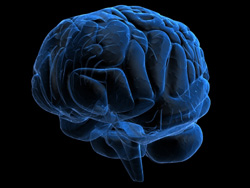What is at play in nervous system pathologies?
In particular, neurotrophins promote the survival of neurons by preventing the latter from starting on the path to programmed cell death (apoptosis). Their functions are mediated on the strength of being able to bind with receptors Trk and p75. One of these neurotrophins is the brain-derived nerve factor (BDNF) that also functions in cell axonal and dendritic growth, as well as plasticity in the nervous system. Trk activation leads to its phosphorylation (addition of a phosphate group to a protein), following which residues act as docking sites for various adaptor molecules. One of these is the recently discovered ARMS/Kidins220. This has been linked to neurotrophin signalling through primary hippocampal and cortical neurons. Researchers have cause to believe that BDNF and ARMS may function together, as changes in BDNF function/expression have been implicated in human brain pathologies. These include depression, and Alzheimer's and Parkinson's diseases. The 'Molecular mechanisms underlying BDNF functions in the brain: role of ARMS protein' (Neurotrophins-ARMS) is working on the hypothesis that ARMS/Kidins220 may be an important molecule in neurotrophin functions. Team members are using biochemical and cellular techniques in combination with molecular biology and genetic approaches to study ARMS/Kidins220. Investigations aim to discover if the expression pattern of ARMS is similar to that of neurotrophins and neurotrophin receptors when the nervous system is still in its development phase. Also of interest is whether ARMS expression levels undergo any changes in cases of brain pathologies where BDNF is altered. Project partners are also studying the role played by ARMS in BDNF-induced dendritic growth and spine/synapse formation during nervous system development. Another project objective is to examine what, if any, role ARMS plays in BDNF-mediated synaptic plasticity during adulthood. In work done to date, studies have revealed that ARMS expression is very high during the embryonic (developmental) stage of the nervous system, declining shortly after birth. BDNF has been shown to participate in massive dendritic growth and synapse formation during nervous system development. The Neurotrophins-ARMS project has experimented with reducing ARMS levels to examine dendritic branching and spine dynamics in neurons. Data indicate that ARMS is important for the correct development of form and structure in dendritic arbours and spines during activity and BDNF-dependent developmental periods. As project work continues, researchers are studying the role of ARMS in BDNF-mediated synaptic plasticity during adulthood. Results obtained so far suggest that ARMS is an important downstream substrate that appears to mediate BDNF functions already investigated. Better knowledge of ARMS/Kidins220 promises to enhance our understanding of neurotrophin functions and the molecular mechanisms playing a role in neurotrophin actions. This is very important as the medical world seeks to better understand the potential role of such growth factors in nervous system pathologies.







